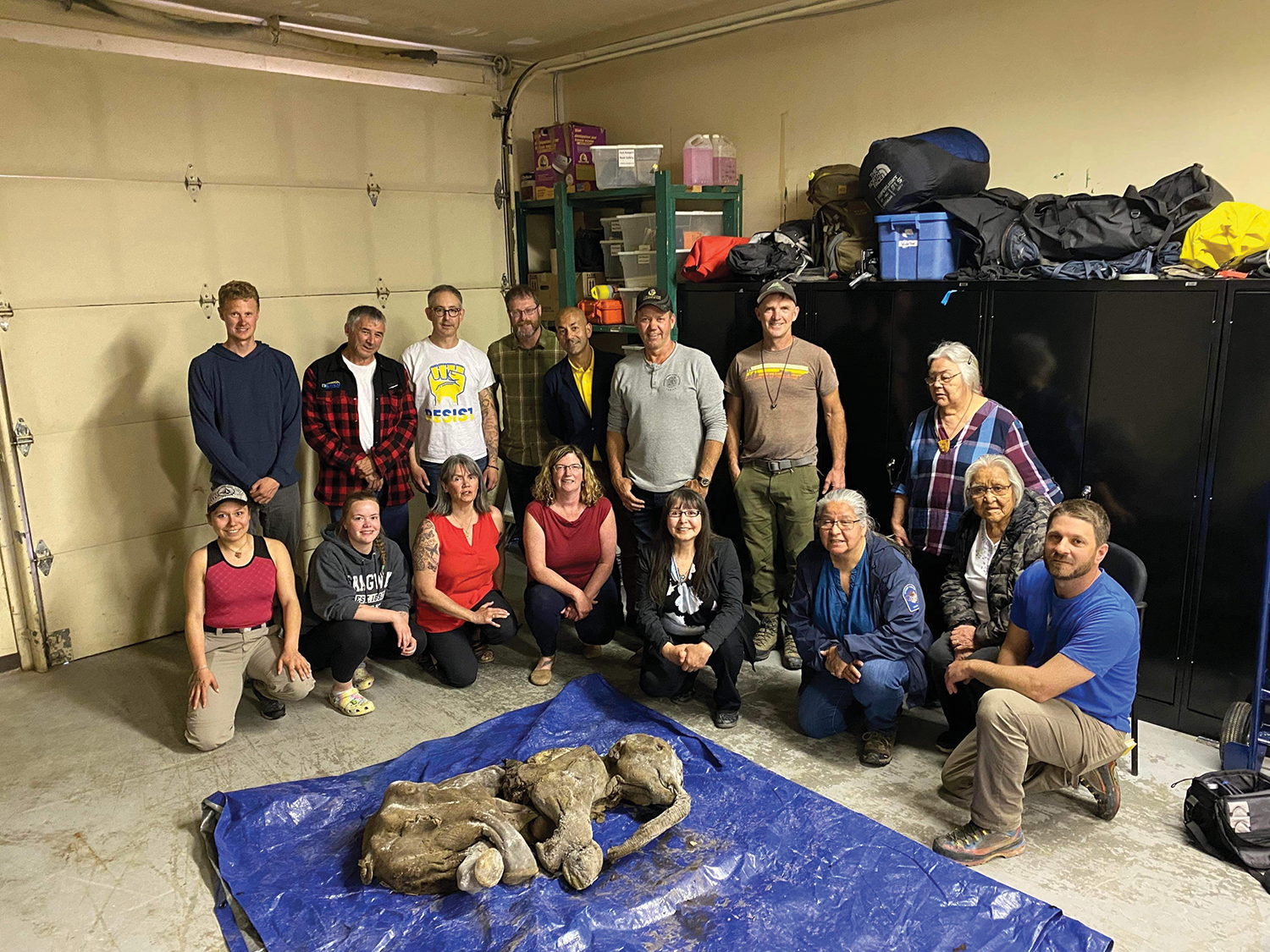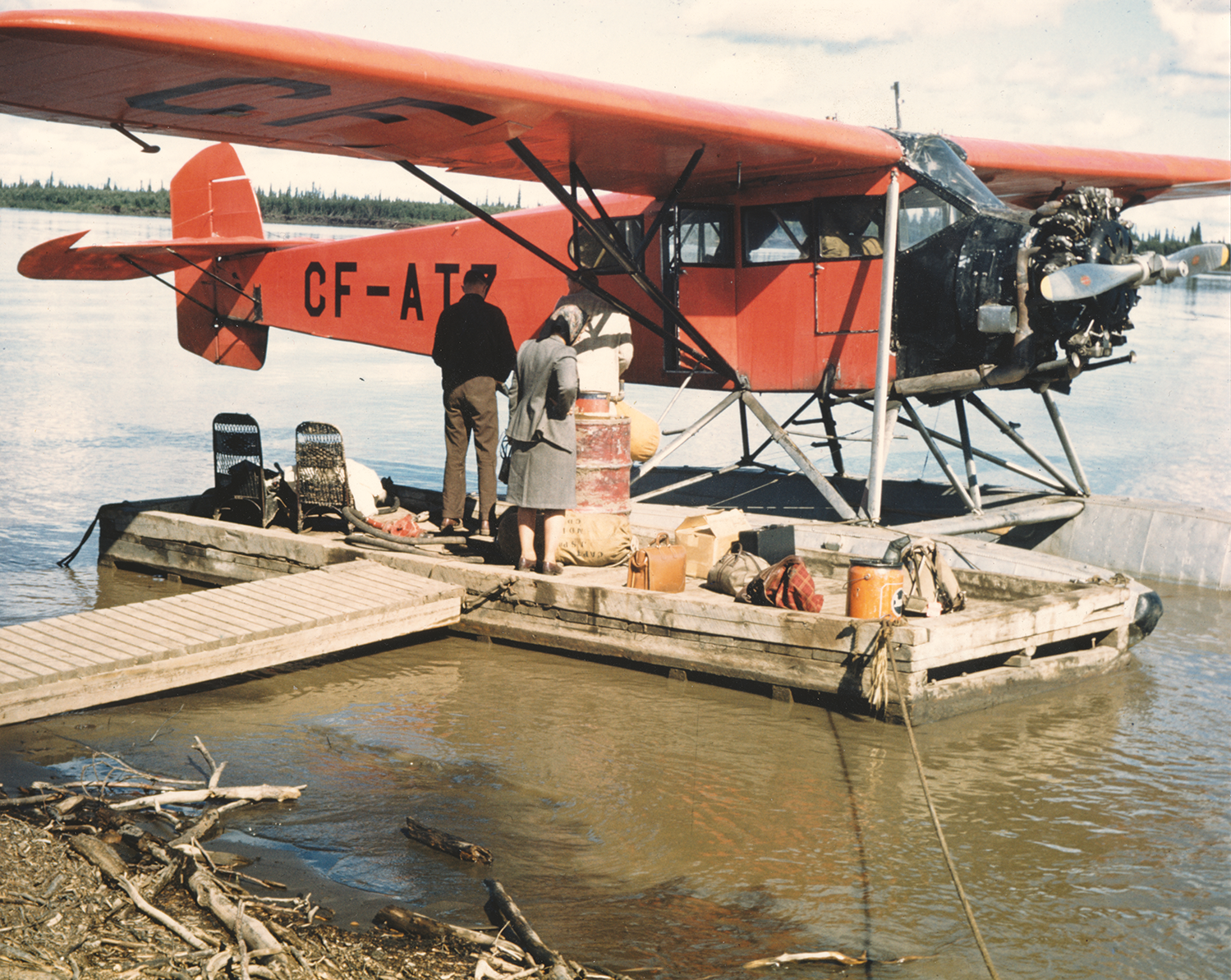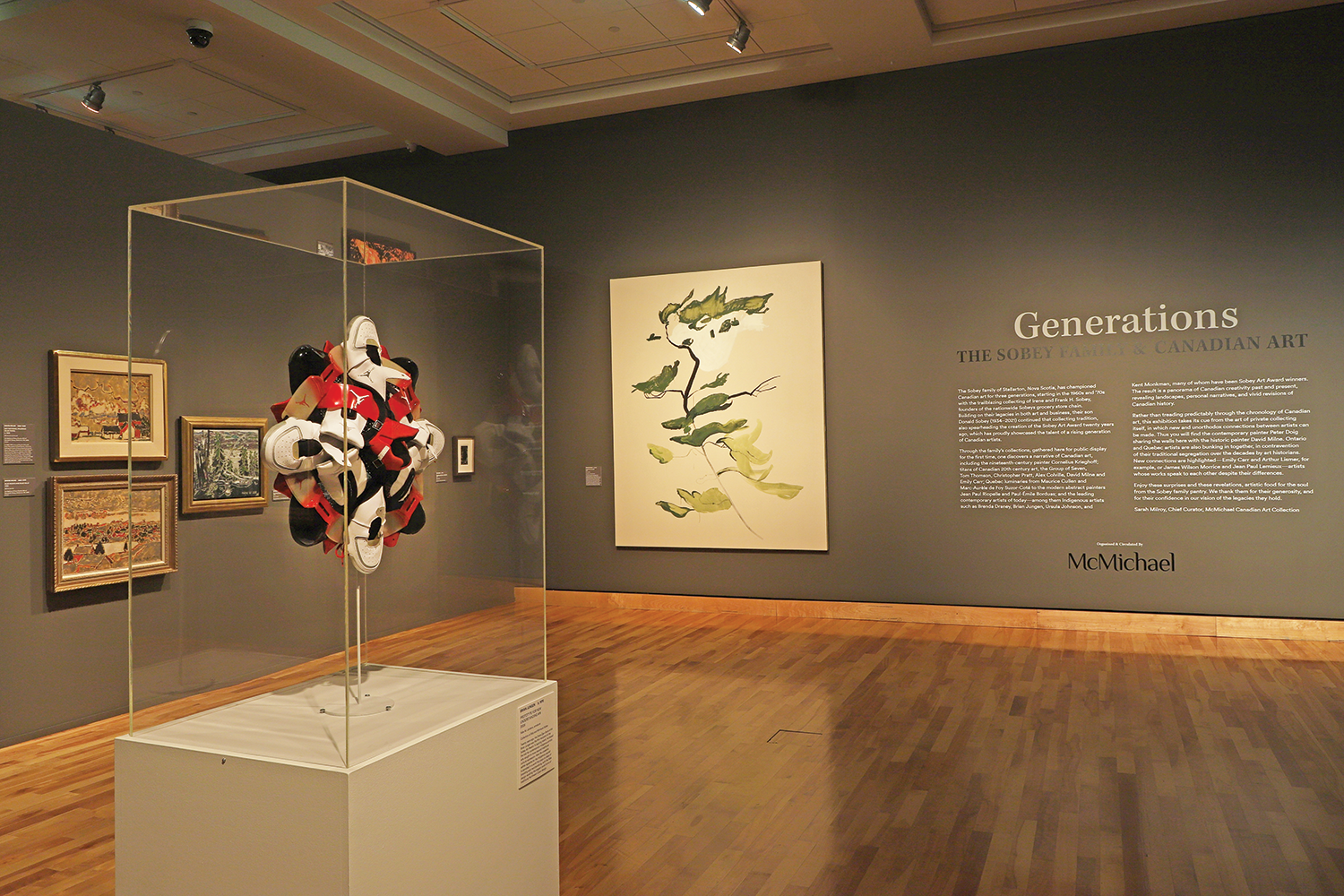In the Spotlight
Whole baby woolly mammoth found frozen in Yukon
New exhibit celebrates Inuit contribution to fashion
Edmonton’s Alberta Aviation Museum risks closure after City withdraws from lease agreement
Montreal Museum of Fine Arts opens first Canadian exhibit space devoted to Sikh art
Sobey family art collection on display at The Rooms
Whole baby woolly mammoth found frozen in Yukon

Members of Trʼondëk Hwëchʼin, Yukon government, Treadstone Gold and University of Calgary with Nun cho ga. Photo — Yukon Government.
A gold miner working in the Klondike gold fields in Trʼondëk Hwëchʼin Traditional Territory found a near-complete baby woolly mammoth while excavating through permafrost. Mining operation was immediately halted and a photo of the discovery was sent to Dr. Grant Zazula, paleontologist for the Yukon government. While many other Ice Age animals have been unearthed in the Yukon, this is the first whole baby woolly mammoth to be discovered in North America, and the second in the world. The mammoth was named Nun cho ga (“big baby animal” in the Hän language) by Trʼondëk Hwëchʼin Elders. Per the Yukon government, they will work together with Trʼondëk Hwëchʼin to “respectfully preserve and learn more about Nun cho ga and share these stories and information with the community of Dawson City, residents of the Yukon and the global scientific community.”
New exhibit celebrates Inuit contribution to fashion

The exhibit during installation featuring an overview of unique regional designs as parkas, dolls and amautis. Photo — Government of Nunavut.
Two new exhibits recently installed at the Iqaluit Airport bring together the past and present of Inuit fashion. Curator of Heritage Collections for the Government of Nunavut, Deborah Kigjugalik Webster, pulled from the 200,000 item collection as well as added community items to showcase the work of talented seamstresses from three regions in Nunavut.
A critical transportation hub in the north, Iqaluit airport sees more than 170,000 passengers annually. Nunavut’s Department of Heritage Collections has sought out alternative display locations due to limited display spaces in the territory. Webster said, “Nunavut currently does not have a main repository for our Heritage Collections and until we have a heritage centre of our own in our Nunavut Territory, we will display our culture and heritage in exhibit spaces available such as the Iqaluit International airport, a hub for Nunavummiut travelling in Nunavut.”
Currently, most of the Nunavut heritage collection is housed out of territory at the Canadian Museum of Nature (140,000 items) and the Winnipeg Art Gallery (8,000 items) with plans for an Inuit Heritage Centre and a series of satellite venues in the works since 2001. The northern-based Centre is directly called for by the Nunavut Agreement, but a $90 million price tag has slowed progress.
The airport display addresses this lack of Inuit representation in the north. A companion display featured a line of Canada Goose parkas designed by Rankin Inlet designer Victoria Kakuktinniq. The Atigi (Inuktitut for “parka”) line offered a different take on the beaded pieces shared in from the historical collection and designs that are still made today. In a radio interview Kigjugalik Webster shared, “The Atigi parkas are featured in New York and different parts of the world, but you don’t get to see them when they travel, so why not bring these parkas north so people can can enjoy them and appreciate the work our seamstresses have done!”
Edmonton’s Alberta Aviation Museum risks closure after City withdraws from lease agreement

Archival photo of the Fairchild 71 (the one in the Alberta Aviation Museum logo, CF-ATZ, shortly before it crashed in the late 40s).
Owned by the City of Edmonton, the historic hangar – Hangar 14 – that the Alberta Aviation Museum (AAM) calls home has recently been in need of repair and refurbishment. Used for training in the Second World War, the hangar is the only remaining double-wide double-long hangar in Canada. Restoration costs are estimated to be at least $41 million.
Following a period of deferring critical maintenance of the hangar, the City administration is recommending that the AAM sells the hangar, which would allow the City to divest from the need to invest in the hangar’s rehabilitation and unload itself of liability. Curator Ryan Lee said he fears the museum will be forced to close after the City withdrew itself from a 25-year lease agreement with AAM after report of restoration costs came out.
A solution to the situation is that the AAM might purchase Hangar 14 and carry out the rehabilitation work in partnership with multiple levels of government and private donors. Currently, the museum is in the process of talking to the City’s infrastructure department to understand the massive discrepancies in the latter’s estimates for how much work the building needs.
Lee feels that AAM is in no danger of getting evicted in the next two years. The City Councillor working with AAM recently passed a motion mandating that whoever purchases Hangar 14 in the next two years must maintain the public museum in the facility.
“Despite two years of COVID, we’re on solid ground, and have been growing an endowment fund at Edmonton Community Foundation,” mentioned Lee. He also noted that the museum has put a significant amount of work into organizational change to ensure its long-term sustainability. These recent developments give the AAM at least two years’ worth of time to plan and implement a sustainable solution.
“I’m optimistic we will find a solution to keep the museum here in Edmonton in the long term. That being said, if things do not go well in our fundraising campaign, there might come a time that we will need to find a new home for the collection” states Lee.
When asked what the AAM would do to preserve the heritage that their organisaton has been stewarding since 1980, Lee mentioned that “we would follow the Alberta Museums Association (AMA) guidelines, reach out to other aviation museums in Alberta and beyond, as well as the City [of Edmonton] and Provincial Archives.”
Montreal Museum of Fine Arts opens first Canadian exhibit space devoted to Sikh art
The Montreal Museum of Fine Arts announced the opening of the first-ever permanent exhibit space in Canada devoted to Sikh art. Works were gifted by Narinder Singh Kapany and Satinder Naur Kapany of the Sikh Foundation International as well as Baljit Singh Chadha and Roshi Chadha. The collection has been installed in the museum’s new Sephan Crétier and Stéphany Maillery Wing for the Arts of One World in the Jean-Noël Desmarais Pavilion, and includes works on paper, ritual objects, rare coins, textiles, accompanied by written works from the period of the British Raj for further context and reflection. “We are privileged to have the opportunity, for the first time in the Museum’s long history, to acquire and showcase a collection of Sikh art of such magnitude. The generosity and foresight of Narinder Singh Kapany, Baljit Singh Chadha and Roshi Chadha have made it possible for the MMFA to take the necessary steps to expand its audience, nurture new perspectives and welcome new voices, so that we may represent the plurality of today’s society,” said MMFA director Stéphane Aquin.
The MMFA exhibit joins a new permanent exhibit, Sikhs in Canada, created by the Sikh Heritage Museum of Canada and displayed at the Ottawa Sikh Society, which presents the history of Sikhs in Canada from 1909 to the present day.
Sobey family art collection on display at The Rooms

Rooms installation view, Generations: The Sobey Family and Canadian Art, exhibition organized and circulated by McMichael Canadian Art Collection. Photo — Courtesy of The Rooms.
To coincide with the 20th anniversary of the Sobey Art Award, The Rooms in St. John’s, NL, is presenting a large collection of Canadian and Indigenous art in a new exhibition. Generations: The Sobey Family and Canadian Art features some 170 works by artists including the Group of Seven, Quebec Impressionists and Automatistes, Annie Pootoogook, Kent Monkman, and many more. The touring exhibition, curated by McMichael Canadian Art Collection senior curator Sarah Milroy, is on display until January 22, 2023 and contains some 170 works from the Sobey family’s collection. The tour will continue to Edmonton and Charlottetown before concluding in Halifax in the fall of 2023.
M
